Best TP-Link router 2024
TP-Link offers modern features and fast Wi-Fi performance with a wide range of routers, including mesh.
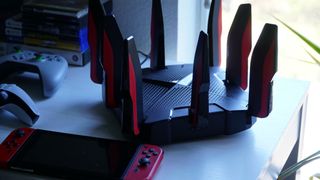
TP-Link has been making networking equipment for ages, and it's quite good at it. Not only that, TP-Link makes some of the best Wi-Fi 6 routers. More often than not, it also offers competitive specifications at great prices. Most of us want to buy a router that will last a few years and provide more than enough speed. The TP-Link Archer AX55 is one of the best TP-Link routers you can get with a fast AX3000 connection that can stand up to all the devices in your home.
These are the best TP-Link routers you can buy
Why you can trust Android Central
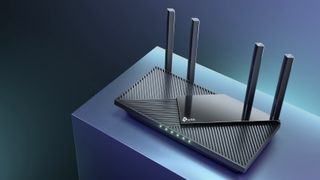
TP-Link Archer AX55 AX3000
Reasons to buy
Reasons to avoid
The TP-Link Archer AX55 is one of the best values you can get when it comes to the best Wi-Fi 6 routers thanks to its fast speeds and solid software offerings. The AX3000 connection breaks down to 2,402Mbps on the 5GHz band and 574Mbps at 2.4GHz. This high 5GHz speed is thanks to its support for 160MHz bands, which allows high-end Wi-Fi clients like gaming PCs to connect at the full 2,402Mbps. It doesn't even go to waste with support for 2Gbps WAN with link aggregation.
While this may seem like overkill, the extra headroom can help keep speeds high even in areas with high congestion like an apartment building. Further aiding congestion mitigation is support for a DFS band that is more often than not vacant. While some areas will not be able to use DFS due to radar interference, most people will have no such issues.
TP-Link has opted for its HomeShield software for security and parental controls with this model. For what you get, the price is reasonable, but it's also worth mentioning that the model this replaced, the AX50, had more features unlocked by default with HomeCare. Even so, the newer AX55 model comes with OneMesh support, so you can expand your coverage with a compatible extender.

TP-Link Archer A7 AC1750
Reasons to buy
Reasons to avoid
Most people don't need absolute top speeds or six antennas on their Wi-Fi system. For a smaller house or apartment, the TP-Link Archer A7 will provide a solid wireless experience. Four gigabit Ethernet ports let this router fit right in with your current wired setup.
You give up a few features for a lower price, such as MU-MIMO and tri-band connectivity, leading to some slowdown if you want to connect many devices at once. Still, with 450Mbps on the 2.4Ghz band and 1300Mbps at 5Ghz, the Archer A7 should be more than adequate.
Traditional styling with tall antennas makes this router harder to blend into a room, but the black color and subtle design mean it won't stand out too much. As a result, this router is a great balance for a network that doesn't need a ton of performance.
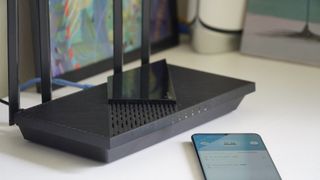
Reasons to buy
Reasons to avoid
The TP-Link Archer AX21 isn't the fastest router you can get by any stretch, but it's fast enough for most homes and comes in at a fantastic price. For the money, you get AX1800 Wi-Fi 6 speeds, four open Ethernet ports, and great software support. The speed breaks down to 1201Mbps at 5GHz and 574Mbps at 2.4GHz. In addition, four Ethernet ports make it easy to connect all of your wired devices at full gigabit speed.
Our Archer AX21 review found that the speeds didn't quite match TP-Link's more expensive models under load, but should be sufficient for a small home with two or three people.
OneMesh support is included with the Archer AX21, allowing users to utilize a OneMesh extender to improve coverage. If you plan to use this router as part of a mesh, keep in mind that the speed will split between connected devices and the connection to other mesh nodes. Being able to expand your home network as needed can be great if you're not sure how much coverage you'll need down the road.

TP-Link Archer AX10 AX1500
Reasons to buy
Reasons to avoid
The TP-Link Archer AX10 is a remarkable value, and it's cheap compared to other entry-level Wi-Fi 6 systems. Thanks to four Ethernet ports and four antennas providing the AX1500 connection speeds, users won't give up much for the price. Compared to many other routers on this list and even some Wi-Fi 5 routers, this is a bit low, but there are other reasons to consider the AX10 other than raw speed.
The Archer AX10 can deliver 1201Mbps at 5GHz and 300Mbps at 2.4GHz. The lower 2.4GHz performance is down to the router only supporting 802.11n or Wi-FI 4 on that band. To put that in perspective, you need around 25Mbps for a 4K video stream most of the time. The key factor is consistency, and with Wi-Fi 6, more devices are supported. Interference will also be less of an issue than with the previous generation of Wi-Fi.
If you're looking for something to keep your network current without the need for top speeds, this can be a great option.
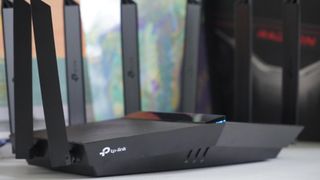
Reasons to buy
Reasons to avoid
The TP-Link Archer AX90 is one of the fastest routers you can get from TP-Link. Second, to only a high-end gaming router, the AX6600 tri-band speeds are more than enough for just about anyone. The speed breaks down to 4804Mbps and 1201Mbps at 5GHz and 574Mbps at 2.4GHz. Around the back, there are five Ethernet ports with one capable of 2.5G speeds. If you already have a fast-wired network or a high-speed fiber connection, you can use the 2.5G port for WAN, though many modern gaming PCs and motherboards are also beginning to ship with 2.5G Ethernet.
Unlike a mesh system, all AX90's wireless speed can be allocated to connected devices, though this router does ship with OneMesh support. Our Archer AX90 review found the speeds to be quick and consistent. If you want to add mesh coverage down the line, you can use a OneMesh compatible extender from TP-Link to create a seamless mesh Wi-FI network.
This is one of TP-Link's first routers with HomeShield Basic included. Like its older HomeCare software, HomeShield Basic adds security features, quality of service, and advanced parental controls. If you want to increase your control level, you can sign up for HomeShield Pro for $54.99 per year or $5.99 per month.
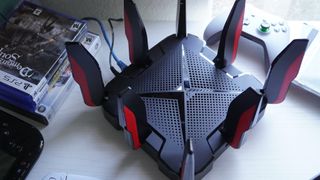
Reasons to buy
Reasons to avoid
The TP-Link Archer GX90 is a tri-band AX6600 WI-FI 6 router. Its speed breaks down to 4,804Mbps on one 5GHz band, 1,201Mbps on the other, and 574Mbps on the 2.4GHz band. The extra speed possible on the higher 5GHz band is thanks to 160MHz support. By default, the faster 5GHz band is labeled as a gaming connection so you can reduce potential interference on your gaming band.
On the back, there are four gigabit Ethernet ports, along with a single 2.5Gbps Ethernet port. The fast port can be configured as WAN or LAN, so whether you want the fastest possible connection to a wired device like a fast NAS or have an existing multi-gig wired network, you can get set up exactly how you want. Around the sides of the router are eight antennas standing straight up.
The Archer GX90 comes packed with TP-Link's HomeCare security software, as well as gaming optimization software. HomeCare provides antivirus protection as well as advanced parental controls allowing you to stay in charge of how much time your family spends online and which sites they visit. As we tested in our Archer GX90 review, the gaming software can be activated to prioritize the gaming connection to keep pings low and most importantly, consistent throughout your entire gaming session. All of this comes together to make it one of the best Wi-Fi 6 routers for gamers and families alike.

Reasons to buy
Reasons to avoid
The TP-Link Deco XE75 is one of the cheapest Wi-Fi 6E routers you can buy which makes it all the more impressive that you get two nodes for a total of 5,500 square feet of coverage. The Deco XE75 cuts some sensible corners to achieve its low price such as not including multi-gig Ethernet and reusing an older node design. At its core, this is a tri-band AXE5400 router with 574Mbps available to 2.4GHz devices with 2402Mbps for both the 5GHz and 6GHz connections.
Unlike some Wi-Fi 6E mesh systems, the Deco XE75 uses 6GHz as the default connection between the mesh nodes. This makes sense for anyone that hasn't upgraded to Wi-Fi 6E Android devices yet and in our Deco XE75 review, we found this configuration delivered great speeds even in an area with a lot of 5GHz congestion. You can however enable this kit to connect directly to Wi-Fi 6E devices if you have them.
Unlike some older Decos, TP-Link has included HomeShield for extra security and parental controls. While the free parental controls will be more than adequate for many families, to get the entire set of features, you'll need to subscribe. Even so, this mesh kit offers a ton of value with great speeds thanks to its creative use of the 6GHz spectrum to boost even older devices in a mesh.
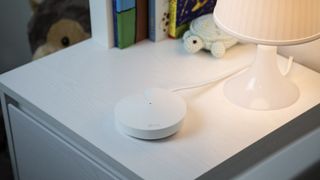
TP-Link Deco M5 AC1200
Reasons to buy
Reasons to avoid
Mesh networking is the biggest trend in Wi-Fi. These routers work together to provide great coverage by combining multiple small routers into a single network. The TP-Link Deco M5 isn't the fastest mesh router around, but with a great price and an easy app-based setup, it is a great option for someone just getting into mesh networking.
This router has two ethernet ports on each one, so you don't need to give up on your wired devices, but the focus here is on Wi-Fi. Speaking of Wi-Fi, this Deco M5 sports a dual-band connection at AC1200 speeds. That's 867Mbps at 5Ghz and 400Mbps at 2.4Ghz. With a three-pack covering an estimated 5,500 square feet, this can be a great solution for a home that's hard to cover with just one router.
Since you'll be placing mesh routers in more rooms of your home, it's nice that the Deco M5 is so small. You can always add more Deco routers if you want to strengthen your network as well.

Reasons to buy
Reasons to avoid
The Deco X90 is the ultimate mesh router from TP-Link and even compared to other brands, and as we saw in our Deco X90 review, one of the fastest mesh systems around. This is all thanks to a more than adequate AX6600 Wi-Fi 6 wireless setup. This speed breaks down to 4804Mbps on one 5GHz channel with 160MHz support, 1201Mbps on the other 5GHz channel, and 574Mbps at 2.4GHz. So if you're looking for a mesh system that can keep pace with a gigabit fiber connection, this is it.
This pack contains two identical nodes, each with two Ethernet ports. One port is gigabit, and the other is 2.5Gbps with auto-sensing WAN/LAN meaning you can connect a fast PC to the 2.5G port or use it for your internet connection, depending on which makes the most sense for your home network. This also means that this is one of the first consumer mesh systems to enable a 2.5G wired backhaul. That's cool.
This, like the Archer X90 above, is one of the first devices to support TP-Link HomeShield. HomeShield is a software package that runs on the router and adds additional security, quality of service, and parental control options. You can also add more features if you're willing to pay for a subscription. The free software will be adequate for most people, but it's nice to have an upgrade option if you want it.
TP-Link has a router or mesh for most homes
TP-Link makes some of the best wireless routers and likely has a solution for anyone's networking needs. Even with intense competition in the mesh space from newer companies like Google and Eero, the Deco mesh routers are a great value whether you need the cheap coverage of the M5 or want to step up to Wi-Fi 6 with the X90. Wi-Fi 6E can even improve mesh speeds with the Deco XE75. Gaming is also an option with quality of service software to keep gaming latency low even when many users are online.
Most people will be delighted with something like the Archer AX21 which manages to be one of the best cheap Wi-Fi 6 routers thanks to its solid speeds and low price. Still, when it comes to value for money, it's hard to beat the Archer AX55 with its AX3000 connection, 160MHz support, and OneMesh support built-in. This is an excellent solution for a family that relies on their home connection for work and entertainment.
Be an expert in 5 minutes
Get the latest news from Android Central, your trusted companion in the world of Android
When Samuel is not writing about networking or 5G at Android Central, he spends most of his time researching computer components and obsessing over what CPU goes into the ultimate Windows 98 computer. It's the Pentium 3.

